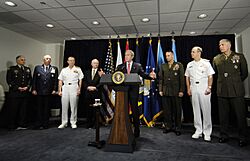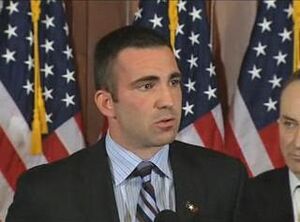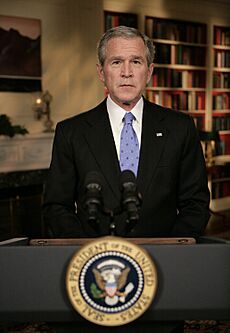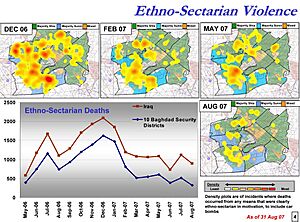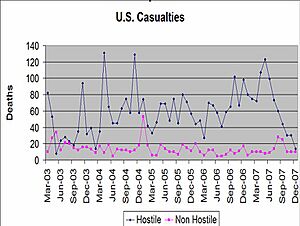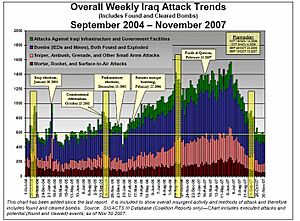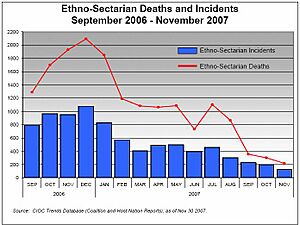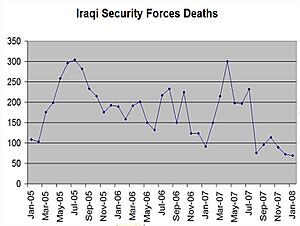Iraq War troop surge of 2007 facts for kids
Quick facts for kids 2007 Iraq War troop surge |
||||||||
|---|---|---|---|---|---|---|---|---|
| Part of Iraq War | ||||||||
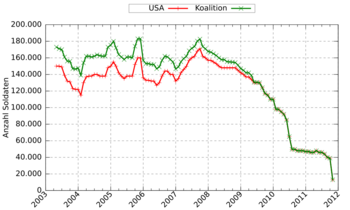 Development of troop strength |
||||||||
|
||||||||
| Conflicts after 2003 invasion of Iraq | ||||||||
|
Post-invasion (2003–09) (2003–09) (2003–09) (2003–09) (2003–08) (2003–05) (2003) (2003–08) (2003–09) (2003–09) (2003–08) (2003–08) (2003–08) (2003–08) (2003–08) (2003–08) (2003–08) (2003–08) (2003–08) (2003–08) (2003–08) (2003–08) (2003–08) (2003–08) (2004–08) (2004–08) (2005–08) (2003–07) (2003–07) (2003–06) (2003–06) (2003–05) (2003–05) (2003–05) (2003–04) (2003–04) (2003–04) (2003–04) (2003–04) (2003–04) (2003–04) (2003–04) Awakening Council Supported by:
|
Post-invasion (2003–11)
|
Supported by: |
||||||
The Iraq War troop surge of 2007, often called the troop surge or simply the surge, was when the U.S. government under President George W. Bush sent more American military troops to Iraq in 2007. The main goal was to make Baghdad and Al Anbar Governorate safer.
This plan was first called "The New Way Forward." President Bush announced it in January 2007 during a TV speech. He ordered over 20,000 more soldiers to Iraq, sending most of them to Baghdad. He also made many U.S. Army and Marine Corps troops already in Iraq stay longer. The President said the main aim was to help Iraq become a "unified, democratic federal Iraq that can govern itself, defend itself, and sustain itself, and is an ally in the War on Terror." A key part of the plan was for the U.S. military to focus on helping Iraqis secure their neighborhoods and protect people. They also wanted to make sure Iraqi forces could keep things safe on their own. Bush believed the surge would create a good environment for different groups in Iraq to come together.
The surge faced strong opposition in the U.S., especially after the Republican party lost many seats in the 2006 midterm elections. Politically, it was a very tough decision. Looking back, some critics of the surge, like Hillary Clinton and Barack Obama, have said it was successful.
Contents
Understanding the Terms
The phrases "New Way Forward" and "A new way forward in Iraq" were used by the White House and news before President Bush's speech on January 10, 2007. The U.S. news also called the increase a "surge" or "Iraq troop surge." After the speech, some politicians started using the word "escalation" instead of "surge," while others used both terms.
Why the Surge Happened
Public Opinion and Elections
The 2006 Election Results
After the 2006 general election, polls showed that most Americans expected Democrats to reduce or end U.S. military involvement in Iraq if they won control of Congress. Democratic leader Nancy Pelosi agreed, saying, "This election is about Iraq." She felt that if the Democrats won, it would mean the American people rejected the President's approach to the war. News outlets saw the Democratic victory in both parts of Congress as a punishment for President Bush and his party over ethics issues and the struggling war in Iraq.
The Democratic View
After her party's win, then House Speaker-elect Pelosi wrote an article titled "Bringing the War to an End is my Highest Priority as Speaker." She explained that after visiting wounded soldiers, she was more determined to end the war. She told her colleagues that the war in Iraq was the biggest ethical issue facing the country. Pelosi stated that the new Democratic Congress would lead with high ethical standards and honor the trust of the American people.
The Republican View
After the 2006 U.S. midterm elections, where Republicans lost control of both the House and Senate, The Heritage Foundation held a meeting. Republican leader Rep. Roy Blunt (R-MO) led the discussion, called "The New Way Forward: Refocusing the Conservative Agenda." They met on November 9, 2006, to understand why they lost the election.
Blunt mentioned that some people thought the loss was a "referendum on the war in Iraq." But he believed no single reason explained it. He said that even with low presidential approval and uncertainty about Iraq, their ideas were gaining support. He felt that their ideas were not defeated, but they themselves were. He also said that the U.S. system shows that no one party stays in power forever. He believed that their political movement needed to constantly update its ideas and make corrections. He said they would continue to fight against terrorism and win the war in Iraq and Afghanistan.
How the Strategy Was Developed
Early Predictions
In 2005, a special computer program called "Senturion" was used to predict what would happen in the Iraqi elections. It suggested that if there were more U.S. troops in Iraq, Iraqis would feel safer and support the elections more. The program showed that a 50% increase in troops would be best, but even a 25% increase would help. It also found that using United Nations peacekeepers instead of U.S. forces could get similar results with fewer troops. These predictions were shared with top government leaders early on.
Iraq Study Group's Advice
On December 6, 2006, the Iraq Study Group shared their report. They suggested ways to improve the situation in Iraq. One idea was for the "United States to significantly increase the number of U.S. military personnel" to help train Iraqi Army units. However, this specific wording wasn't in their official recommendations. The report mentioned a possible 10,000-20,000 troop increase for training until early 2008. The group's co-chairman, James Baker, said that leaders should make decisions quickly. President Bush said he would take every idea seriously.
Later that day, White House spokesman Tony Snow said President Bush was comparing the Iraq Study Group's ideas with other studies. Snow believed the President would announce a "new way forward" for Iraq by the end of the year.
State Department's Role
On December 11, 2006, President Bush met with top advisors from the State Department, including Secretary of State Condoleezza Rice. They discussed how to shape U.S. policy in Iraq. Bush said he wanted to announce his new strategy before Christmas 2006. He stressed that the State Department and Defense Department needed to work together closely. This way, when he spoke to the American people, they would know he had considered all parts of the government.
Expert Opinions
Also on December 11, 2006, President Bush met with a group of Iraqi experts. These included historians and retired generals. The Washington Post reported that some experts, like retired General Jack Keane, thought adding several thousand more soldiers could improve security in Baghdad. Others doubted this idea. The group also suggested that Bush change some of his national security team. One expert said, "All of us said they have failed, that you need a new team." The President thanked them, saying their advice was important for creating a "new way forward in Iraq."
The CIA's experts on fighting rebellions also found that U.S. forces were key to keeping things stable. They noted that when U.S. forces were present, they could help solve local problems and prevent illegal actions by Iraqi forces.
Joint Chiefs' Advice
On December 13, 2006, President Bush and Vice President Dick Cheney met with the Joint Chiefs of Staff, who are top military leaders. They discussed different military options for Iraq. The Chiefs did not want to add many more troops to Iraq. Instead, they thought strengthening the Iraqi army was key to stability. They also pushed for more U.S. efforts in rebuilding Iraq's economy and helping different groups get along.
They said there was "no purely military solution for Iraq." They believed that without major progress in politics and the economy, the U.S. effort would only buy time. They also warned that any new strategy should consider the wider region. They worried that too much support for one group might cause other countries to support opposing groups.
The Chiarelli Plan
General George William Casey Jr., the top U.S. commander in Iraq, was looking at a plan to change the American military's mission. This plan, from Lt. Gen. Peter W. Chiarelli, suggested moving U.S. troops out of Iraqi cities. They would gather at U.S. bases, and Iraqi forces would take over daily combat duties. The plan also considered adding more troops for training the Iraqi army.
Under the Chiarelli plan, about half of the 15 U.S. combat brigades would switch from fighting to training Iraqi security forces by spring 2007. The plan would add 30 troops to each training team, allowing them to guide Iraqi army companies. The remaining U.S. combat forces would focus on fighting al-Qaeda, securing Iraq's borders, and protecting major roads. This plan would not mean a big reduction in U.S. troops, nor would it call for a "surge."
The Joint Chiefs were worried about the U.S. military's ability to handle other crises worldwide because of the heavy commitment in Iraq. They told Bush that there was a "significantly increased risk" if a new emergency happened.
After the meeting, President Bush told reporters, "Our military cannot do this job alone. Our military needs a political strategy that is effective." He also said he was committed to securing Iraq. He warned that if the U.S. lost its resolve, Iraq could fall to enemies. When asked when he would announce his new plan, he said he would not be "rushed" and was still reviewing his options.
December 14 Comments
On December 14, 2006, President Bush said he was listening to a lot of advice to create a strategy. He stated he would announce his plans after careful thought and would not be rushed. He mentioned hearing "interesting" ideas, but also "ideas that would lead to defeat," such as leaving before the job was done. He rejected those ideas. He also wanted the new Defense Secretary Robert Gates to have time to evaluate the situation. That same day, Iraqi President Jalal Talabani said Bush had promised not to make decisions that would go "against your interests."
The announcement on "the new way forward" was delayed to give the President more time to gather information. Press secretary Tony Snow said the administration hoped the President would give the speech before Christmas, but the exact timing was not set.
Support for the Surge
The American Enterprise Institute (AEI) published a study on December 14, 2006. Its author called it the "real Iraq Study Group report." The final report was released on January 5, 2007, titled "Iraq: A Turning Point." It called for a large and steady increase of U.S. forces to secure Baghdad. The report was created with military and regional experts.
Andrew Ross of the San Francisco Chronicle linked Bush's strategy to this AEI report. He wrote that President Bush's Iraq strategy included more money for rebuilding, creating jobs, and supporting "moderate Iraqi political parties." This broader approach, reportedly called "The New Way Forward," was similar to the AEI paper.
The Plan Is Announced
Before the Speech
President Bush was expected to announce a "surge" of up to 20,000 troops. Reuters reported that while Bush would announce a full change in his Iraq policy, the troop increase got the most attention. Bush had hinted that he preferred increasing troops to help Iraqis control their security. He said he wanted the mission to be "clear and specific and can be accomplished." Bush's proposed increase was 21,000 U.S. troops. Of these, 4,000 Marines would focus on Al Anbar Governorate, and the rest would join Iraqi units to secure Baghdad.
Disagreements Beforehand
Just before the 110th Congress met on January 4, some Democrats said they planned to call Defense Secretary Robert Gates to explain the President's plan.
Before the speech, U.S. Senator Jack Reed (D-RI) held a press conference with former NATO Commander General Wesley Clark and Jon Soltz. They, along with Senators Chuck Schumer (D-NY) and Patty Murray (D-WA), asked Bush to listen to his generals and the American people. They wanted him to offer a new plan to change course in Iraq.
The Announcement
In a TV speech on January 10, President Bush said, "America will change our strategy to help the Iraqis carry out their campaign to put down sectarian violence and bring security to the people of Baghdad." He added, "This will require increasing American force levels. So I've committed more than 20,000 additional American troops to Iraq. The vast majority of them – five brigades – will be deployed to Baghdad."
On the same day, ABC News reported that ninety advance troops from the 82nd Airborne Division had already arrived in Baghdad.
2007 State of the Union Address
Before his State of the Union address, President Bush gave several speeches. He suggested that the surge "should be given a chance" and challenged lawmakers who disagreed to offer another plan.
On January 23, the President spoke about the troop increase in Iraq. He explained its purpose was to help the Iraqi government keep control:
In order to make progress toward this goal, the Iraqi government must stop the sectarian violence in its capital. But the Iraqis are not yet ready to do this on their own. So we're deploying reinforcements of more than 20,000 additional soldiers and Marines to Iraq. The vast majority will go to Baghdad, where they will help Iraqi forces to clear and secure neighborhoods, and serve as advisers embedded in Iraqi Army units. With Iraqis in the lead, our forces will help secure the city by chasing down the terrorists, insurgents, and the roaming death squads. And in Anbar Province, where al Qaeda terrorists have gathered and local forces have begun showing a willingness to fight them, we're sending an additional 4,000 United States Marines, with orders to find the terrorists and clear them out. (Applause.) We didn't drive al Qaeda out of their safe haven in Afghanistan only to let them set up a new safe haven in a free Iraq.
Putting the Plan into Action
Leadership Changes
Along with the troop surge, the Bush administration made several changes in leadership:
- CENTCOM Commander – Navy Admiral William J. Fallon took over from General John Abizaid.
- Commander of Multinational Force Iraq – counter-insurgency expert General David Petraeus replaced General George Casey.
- U.S. Ambassador to Iraq and Ambassador to the United Nations – Bush appointed U.S. diplomat Ryan C. Crocker as the new ambassador to Iraq. Zalmay Khalilzad, the former ambassador to Iraq, was nominated to become the U.S. Ambassador to the United Nations. He was the first Muslim to hold this position.
- U.S. National Intelligence Director – John Negroponte resigned and became Deputy Secretary of State. Retired Admiral John M. McConnell took his place.
- White House Counsel – Harriet Miers stepped down and was replaced by Fred Fielding.
Troops Sent to Iraq
Six U.S. Army brigades were sent to Iraq as part of the surge:
- 2nd Brigade, 82nd Airborne Division (Infantry): 3,447 troops. Sent to Baghdad in January 2007.
- 4th Brigade, 1st Infantry Division (Infantry): 3,447 troops. Sent to Baghdad in February 2007.
- 3rd Brigade, 3rd Infantry Division (Heavy): 3,784 troops. Sent to southern Baghdad Belts in March 2007.
- 4th Brigade, 2nd Infantry Division (Stryker): 3,921 troops. Sent to Diyala Governorate in April 2007.
- 2nd Brigade, 3rd Infantry Division (Heavy): 3,784 troops. Sent to southeast Baghdad in May 2007.
- 1st Brigade, 10th Mountain Division (Light): Sent to Kirkuk in September 2007.
This increased the number of U.S. brigades in Iraq from 15 to 20. Also, 4,000 Marines in Al Anbar had their 7-month tours extended. Most of the 150,000 Army personnel also had their 12-month tours extended. By July 2007, almost 30% of the mobilized Army and 13.5% of the mobilized Marine Corps were in Iraq and Afghanistan.
Military Operations
The plan started with a major operation to secure Baghdad, called Operation Fardh al-Qanoon (Operation Imposing Law), in February 2007. However, major efforts to fight the insurgency fully began only in mid-June 2007, after all 28,000 additional U.S. troops had arrived. Operation Phantom Thunder was launched across Iraq on June 16. It included other operations targeting insurgents in Diyala and Al Anbar Governorates and the southern Baghdad Belts. The surge troops also took part in Operation Phantom Strike and Operation Phantom Phoenix.
New Counterinsurgency Strategy
The strategy for fighting the insurgency in Iraq changed a lot under General Petraeus after the 2007 troop surge began. The new approach aimed to win the support of the Iraqi people. This was done by building relationships, avoiding harm to civilians, and even working with some former enemies. This new strategy focused on protecting the population rather than just killing insurgents. Petraeus used his experience from commanding the 101st Airborne Division in Mosul in 2003. He also wrote about these ideas in a military guide called Field Manual 3-24: Counterinsurgency.
Instead of seeing every Iraqi as a possible enemy, the new strategy focused on building trust and getting Iraqis to cooperate against Al Qaeda. The goal was to reduce the number of enemies for U.S. forces. The belief was that having troops stay in a community for a long time would improve security and help build trust between locals and the U.S. military. Civilian injuries were reduced by using force carefully. This meant less bombing and overwhelming firepower, and more soldiers using restraint, even if it meant taking more risks.
Another way to gain cooperation was by paying locals, including former insurgents, to work as local security forces. Former Sunni insurgents were hired by the U.S. military to stop working with Al Qaeda and start fighting against them. To do this, troops were concentrated in Baghdad, as the city had 50% of all the violence in Iraq at the time. In the past, Coalition forces stayed away from Iraqis in large bases. But during the surge, troops lived among Iraqis, operating from joint security stations (JSSs) inside Baghdad, shared with Iraqi forces. U.S. units were permanently assigned to an area to build long-term relationships with the local Iraqi people and security forces.
However, some people who opposed the occupation of Iraq, like retired U.S. Army officer David Hackworth, questioned this. He felt the British military was better at working with the Iraqi public. He said Americans were "heavy-handed" and didn't understand the people and culture. CNN reporter Michael Ware, who reported from Iraq since before the 2003 invasion, also had doubts. He said there would be "mixed reaction in Iraq" to a long-term U.S. troop presence. He wondered if it would be worth it, suggesting that occupation could "ferment further resentment."
What Happened After the Surge
Security Improvements
For the first few months of the surge, violence actually went up. But by the fall of 2007, the security situation had gotten much better. U.S. military deaths dropped from a high of 126 in May 2007 to 23 in December. After the surge (from June 2008 to June 2011), the average monthly deaths were less than 11. In May 2007, over 1,700 Iraqi civilians were killed, but this fell to about 500 in December. The average from June 2008 to June 2011 was around 200.
On September 10, 2007, David Petraeus presented his report to Congress. He said that the military goals of the surge were "in large measure, being met." He pointed to recent drops in violent incidents, which he linked to successes against Al-Qaeda in Iraq during the surge. He also said they had stopped Shia militia extremists. He argued that U.S. and Iraqi operations had greatly reduced violence between different groups, though not everywhere equally. He suggested a slow reduction of U.S. forces, aiming to reach pre-surge levels by July 2008. He felt that further withdrawals would be "too soon."
While Petraeus gave credit to the surge for less violence, the decrease also happened around the same time that Iraqi political leader Muqtada al-Sadr ordered a cease-fire on August 29, 2007. Al-Sadr told his followers to stand down for six months after more than 50 Shia Muslim pilgrims died in fighting the day before.
Michael E. O'Hanlon and Jason H. Campbell of the Brookings Institution said on December 22, 2007, that Iraq's security was the best it had been since early 2004. They credited Petraeus's strategy for this improvement. CNN reported that month that the monthly death rate for U.S. troops in Iraq was at its second lowest point since the war began. Military officials said the drop in violence and deaths was directly due to the troop surge. The Iraqi Ministry of Interior also reported similar drops in civilian deaths.
However, on September 6, 2007, a report by an independent military group led by General James Jones suggested that the decrease in violence might be because some areas were taken over by either Shias or Sunnis. Also, in August 2007, organizations reported that more Iraqis had fled their homes since the troop increase.
On February 16, 2008, Iraqi Defense Minister Abdel Qader Jassim Mohammed told reporters that the surge was "working very well." He said Iraq urgently needed troops to stay to secure its borders. He stated, "Results for 2007 prove that – Baghdad is good now."
In June 2008, the U.S. Department of Defense reported that "the security, political and economic trends in Iraq continue to be positive; however, they remain fragile, reversible and uneven."
In July 2008, U.S. forces lost only 13 soldiers. This was the lowest number of U.S. casualties in one month since the 2003 invasion of Iraq. Also, a report from the U.S. embassy in Baghdad, given to Congress in May 2008, said that the Iraqi government had met 15 of the 18 political goals set for them.
The surge allowed troops to have more control over city areas that insurgents used to hold. This led to an overall slowdown of the fighting.
Political and Economic Progress
The U.S. Government Accountability Office (GAO) reported on September 2, 2007, that the Iraqi government had only met three of the eighteen goals set by the U.S. Congress in June 2006. Other government reports also measured progress in Iraq. USA Today and The New York Times compared these findings. Another GAO report said the Iraqi Government did not meet 11 of the 18 goals by August 30, 2007. On September 14, a White House survey reported "satisfactory" progress on 9 of the 18 goals.
Lionel Beehner of the nonpartisan Council of Foreign Relations said the goals were "vague" because it was hard to measure them precisely. The New York Times stated on May 13 that "Nobody in Washington seems to agree on what progress actually means." General David Petraeus, commander of the Multinational force in Iraq, said his troop recommendations did not depend on whether the Iraqi government met these goals.
On December 2, 2007, the Sunni Arab Iraqi Accord Front ended their boycott of the Iraqi Parliament. On January 20, 2008, Iraq's parliament passed a law allowing members of the Ba'ath party to return to public life. This was a major U.S. congressional goal for the Iraqi government's success. That month, the International Monetary Fund (IMF) said Iraq's economy would grow a lot from the previous year. The IMF predicted Iraq's oil production would increase significantly in 2008. They also expected Iraq's gross domestic product (GDP) growth to jump to over 7% in 2008 and 2009, up from just 1.3% in 2007.
On December 22, 2007, Michael E. O'Hanlon and Jason H. Campbell of the Brookings Institution said Iraq's economy and political system were "only marginally better than a year ago." The U.N. envoy to Iraq, Staffan de Mistura, praised the Iraqi government's work in late 2007. He said that while he was worried about the lack of national dialogue at the start of 2007, "today that has substantially changed." He said the U.N. report would "compliment" Iraq's government on its efforts to bring different groups together.
In January 2008, Council of Foreign Relations fellow Michael E. O'Hanlon said that "Overall, Iraq's political system probably merits a grade of roughly C for its performance over the last 12 months." He also noted that "the pace of progress is finally picking up."
On February 13, 2008, the Iraqi parliament passed three important laws. These included an amnesty law, a law defining provincial powers, and the 2008 budget. The amnesty law was one of the goals set by President Bush. The provincial powers law included a plan for provincial elections, another key goal. The budget was expected to create up to 700,000 new jobs for Iraqis.
USA Today stated on February 17, 2008, that U.S. Ambassador to Iraq Ryan Crocker "may be hard-pressed to argue that Iraqis have met political benchmarks Congress sought." This highlighted the difference between military progress and political progress.
Images for kids
More to Explore
- 110th United States Congress
- 2006 United States general elections
- 2007 in Iraq
- 2007 State of the Union address
- American Enterprise Institute
- Iraq insurgency
- Iraq Study Group
- Iraq withdrawal benchmarks
- July 12, 2007, Baghdad airstrike associated with WikiLeaks in 2010
- Kerry–Feingold Amendment
- Report to Congress on the Situation in Iraq
- Special Activities Division
- Strategic reset
- Timeline of the Iraq War troop surge of 2007


